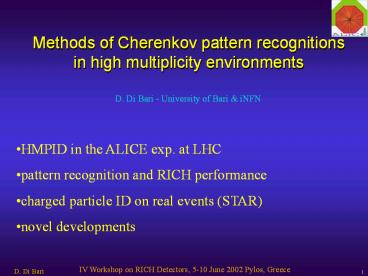Methods of Cherenkov pattern recognitions in high multiplicity environments - PowerPoint PPT Presentation
1 / 23
Title:
Methods of Cherenkov pattern recognitions in high multiplicity environments
Description:
Methods of Cherenkov pattern recognitions in high multiplicity environments D. Di Bari - University of Bari & iNFN HMPID in the ALICE exp. at LHC – PowerPoint PPT presentation
Number of Views:95
Avg rating:3.0/5.0
Title: Methods of Cherenkov pattern recognitions in high multiplicity environments
1
Methods of Cherenkov pattern recognitions in high
multiplicity environments
D. Di Bari - University of Bari iNFN
- HMPID in the ALICE exp. at LHC
- pattern recognition and RICH performance
- charged particle ID on real events (STAR)
- novel developments
2
Pysics Motivation
- ALICE is a multi-purpose experiment
- aim study the properties of the Quark Gluon
Plasma - HMPID to identify charged particles with high pT
in the central rapidity region (h lt 1) - 1 lt pT lt 3 GeV/c p/K
- 1.5 lt pT lt 6 GeV/c p
- Sub-detectors designed for Pb-Pb collisions at
?s5.5 TeVA with anticipated multiplicity dN/dy
8000 - ?
- 10-15 pad occupancy for RICH (80-100 part/m2)
3
(No Transcript)
4
(No Transcript)
5
- Momentum from TPC
- Matching between extrapolated
- point and MIP on the RICH
6
Detector response
7
Simulation with ALIROOT (C)
8
Pattern recognition in ALICE
The Hough Transform Method (HTM) represents an
efficient implementation of a generalized
template matching strategy for detecting complex
patterns in binary images (looking for local
maxima in a feature parameter space)
(x,y) ? ((xp,yp,qp,jp), hc)
cluster coordinate
photon Cerenkov angle
impact track parameter
?
solution in one dimensional mapping space hc
9
hc reconstructed theta Cherenkov for each
photon qc reconstructed theta Cherenkov per
particle
geometrical backtracing reconstruction of the
angle under which the candidate photon could
have been emitted
quartz window
photon cluster
C6F14
MIP
incoming particle
CH4
radiator
proximity gap
10
- background estimate
- hypotesis ? background uniformly distrib.
- the photons falling in opening bands of 10 mrad
are weighted for the corresponding band area
11
(No Transcript)
12
(No Transcript)
13
Efficiency and contamination
Efficiency and contamination as a function of the
track momentum (dN/dy 8000)
14
installation of the proto-2 in the STAR
experiment unique opportunity to test the
detector 5(?) years before the ALICE start
15
Reconstructed Theta Cherenkov vs. track momentum
in STAR
positives negatives
pth ? 1.26 m GeV/c
16
Sample of events with track of p gt1GeV/c
17
Evaluation of Nsat
Nph 15 _at_ CERN test beam (in 2000 data lower
gain)
18
Tuning of the n(l,T)
19
Fitted peak positions for ?/K/p in agreement with
the expected ?Cherenkov vs. pt curves
?
?/K and K/p separation as function of pt
?
20
negatives
p-
K-
p
positives
p
K
p
21
Charged particle ratios with RICH in STAR
- not corrected for
- acceptance
- efficiency
22
Proton Identification efficiency
??p ?-
- (Anti)Proton identification efficiency has been
evaluated by the identification of the (anti)
protons coming from the charged dacay of
(anti)lambda
overall efficiency in the range 1.5 lt pT lt 2.5
GeV/c
candidates identified efficiency () err ()
protons 157 126 80.3 3.2
antiprotons 81 64 79.0 4.5
23
Support Vector Machines
- SVM is a new (1995) and promising classification
technique with high generalization power. - It is particularly apts with complex images.
Basic idea separate the classes with a surface
that maximizes the margin between them and
minimize the error in the misclassification of
data.
- RICH Classification problem pions/kaons/protons
discrimination. - Input space photon Cherenkov angles.
- Output space class membership probability.
References 1) E.E. Osuna, R. Freud, F. Girosi,
Support Vector Machines Training end
Applications MIT, (1997). 2) M. Feindt, C. Haag,
DELPHI Collaboration, Support Vector Machines
for Classification Problems in High Energy
Physics, Institute fur experimentelle Kernphysik,
Universitat Karlsruhe, (1999). 3) L. Maglietta,
Support vector machines for electron/antiproton
discrimination by a transition radiation
detector (Pamela exp.), Università degli Studi
di Bari, Thesis Degree, march 2002.






























